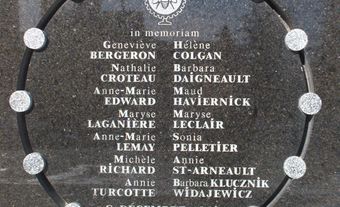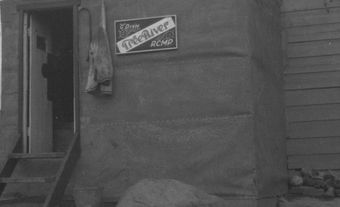This article was originally published in Maclean’s magazine on December 6, 1999. Partner content is not updated.
The nightmares that haunted Heidi Rathjen for such a long time seem to have disappeared. For years, she snapped awake at night, tormented by remembered sounds of screams, shouts and the popping of an assault rifle.The nightmares that haunted Heidi Rathjen for such a long time seem to have disappeared. For years, she snapped awake at night, tormented by remembered sounds of screams, shouts and the popping of an assault rifle. Rathjen was reliving real life: on Dec. 6, 1989, she spent 45 minutes huddled in silent terror in a student lounge at the University of Montreal, while Marc Lépine, a 25-year-old semi-recluse with a hatred of women, roamed the halls, shooting at any female he saw. "Whenever we thought things had quieted down," Rathjen recalled later, "another round of bullets would shatter the silence, smashing our hopes." By the time Lépine's rampage ended as he turned the gun on himself, he had killed 14 women and wounded another 13 people. Rathjen, then a 22-year-old engineering student at the university's Ecole polytechnique and now an anti-tobacco activist, considers herself "one of the lucky ones: the nightmares are a small thing next to keeping my life."
That may be so - but like so many people in and outside the university that day, her life changed forever. In many ways, it is only now, on the eve of the 10th anniversary of what has become known as the Montreal Massacre, that the full consequences are clear. Along with the lost and shattered lives of the dead and bereaved, Canadians confronted the circumstances that led to the killing. One consequence was more rigorous gun-control legislation - and a bruising debate on the subject that still continues. "The assumptions that most Canadians made about gun regulation in our country changed forever that day," says Wendy Cukier, the Toronto-based president of the Coalition for Gun Control. She speaks from firsthand experience: although she did not know any of the victims, she co-founded the coalition as a direct result of the massacre.
The deaths also caused men and women alike to confront the contentious question of whether Lépine, who carried an anti-feminist manifesto with him, was simply a crazed social outcast - or a shocking manifestation of the deep-rooted hatred some men have against women. "My view," says Rathjen, "is that it is too easy to just dismiss him as crazed."
A decade later, this year's commemorative events will be the biggest yet. Most major Canadian municipalities planned at least one ceremony marking the anniversary. Montreal, Toronto, Edmonton and Vancouver are among the cities that established memorials, and the anniversary is always observed in the House of Commons.
Not surprisingly, ceremonies and other efforts are held on the largest scale in Quebec. Last week, 14 female singers from the province released a song called Quatorze (Fourteen) in memory of the dead, with proceeds earmarked for a foundation for families of the victims. In Montreal, more than 10,000 people, many of them students who are being given the day off, will attend an anti-violence rally on Dec. 6 at the Molson Centre. Later, the Montreal Symphony Orchestra will give a concert at which it will perform Mozart's Requiem, and the next night, some of Quebec's top singers will hold another benefit. As they do each year, survivors of the massacre, and victims' families, will meet at a plaque at the University of Montreal not far from Room 303 - where Lépine began his mass killing.
The toll of death and wasted lives began - but did not end - there. In his killing spree, Lépine divided men and women into two groups, and then shot the women while the men stood by, helpless. Eight months later, one male witness, unable to bear his guilt at doing nothing, killed himself. Ten months after that, his grief-stricken parents took their own lives. And Nadia Gharbi, the extroverted younger sister of Lépine who had often taunted him, became haunted and drug-addicted in the aftermath, and died of an overdose at age 28. Others who witnessed the event have had a variety of psychological troubles.
In life, Lépine was known as a shy, stoic loner. He had no police record, and did not smoke, drink or use drugs. In retrospect, his hobbies and failings appear as signposts to the explosion that was to come. One former teacher recalled his "strange, faraway eyes," and said he seldom seemed happy. A friend recalled Lépine "had a lot of problems" with girls and never had a committed relationship. He never held a job for long, and had few interests or obvious abilities - with one notable exception. He liked and was proficient at target shooting, and could track and kill birds in flight with one shot.
When Lépine undertook his rampage, witnesses said he stayed calm throughout, spraying bullets about him, then carefully reloading.
The killings forced Canadians to reconsider the oft-repeated boast that death by gunfire is an American phenomenon. And the women were all, by definition, exceptionally bright and talented: the University of Montreal's engineering faculty is widely recognized as the best in Quebec, and among the best in Canada. The fact that the slain women seemed to have been targeted because of their brains and ability spurred others into action. Cukier, the mother of a girl who was one year old at the time of the shooting, was deeply moved. In her off-hours from her job teaching business and justice at Toronto's Ryerson Polytechnic University, she began clipping names from newspapers of people commenting on the need for new gun legislation. She wrote them with an invitation to join her nascent Coalition for Gun Control - and a movement was born that today claims about 12,000 supporters and the backing of about 350 organizations. Both critics and supporters say the coalition was instrumental in the passage of Bill C-17 in 1991 and the Firearms Act in 1995. The most recent law requires registration of all firearms, screening licences for gun owners, a national information system on gun owners and their firearms, and a ban on semi-automatic military assault weapons. It has saved lives, Cukier insists, but, she adds, "we don't pretend any legislation could have stopped the massacre."
That, say opponents, is one of the reasons why the legislation is an expensive and unnecessary intrusion into the rights of law-abiding gun owners. By the time it is fully implemented in 2001, the gun-registration process will have cost taxpayers about $300 million. And by forcing a lengthy and complex registration process, says Reform party MP Garry Breitkreuz, the party's critic on the issue, "the government is making it hard for decent people to abide by the law, and doing nothing to punish those already intent on breaking it." Similar feelings run high in rural areas, where gun use is a part of everyday life. Reform strongly opposes the legislation: so does about half the New Democratic Party caucus; and the Alberta, Saskatchewan, Manitoba, Ontario and New Brunswick governments are jointly challenging the legislation's constitutionality before the Supreme Court.
Rathjen, who worked with Cukier until 1996, left the coalition after the legislation passed because she felt "most of the battle was won." But Cukier continues as a "full-time volunteer" because, she says, "I'm still afraid of what a noisy minority can do to change things." Over the years, she has received hate mail, boxes of manure and several death threats. But on a personal level, she sees one upside. Her 11-year-old daughter, Sarah, "grew up hearing continually about current affairs, and she's got strong views on some pretty complex issues." As for the gun-control law, says Cukier, "Sarah grew up thinking she is responsible for it." And while debate continues over the legislation's effectiveness, everyone hopes her generation will never have to confront the lethal combination of anger, agony and anguish that led to its creation.
Maclean's December 6, 1999

 Share on Facebook
Share on Facebook Share on X
Share on X Share by Email
Share by Email Share on Google Classroom
Share on Google Classroom


